By: Engelbert Humperdinck
Week: 1
'Hansel and Gretel' presents an opera in three acts. German composer Engelbert Humperdinck created the music, and librettist Adelheid Wette wrote the libretto. 'Hansel and Gretel' consists of the German version of the old nursery legend 'Babes in the Wood.' The first scene of 'Hansel and Gretel' discloses a wretched homestead. The two children, Hansel and Gretel, work hard at their tasks, the boy making brooms and the girl knitting stockings. They both complain of feeling very hungry, and they have no food in the house. There is only a jug of milk that will make nice blancmange when mother comes home. Hansel sneaks a taste, and Gretel raps his fingers. Hansel refuses to work anymore and proposes they dance instead to Gretel's delight. Hansel dances awkwardly at first, but Gretel teaches him the steps. They get along so famously that they whirl around the room and fall exhausted to the floor [1].
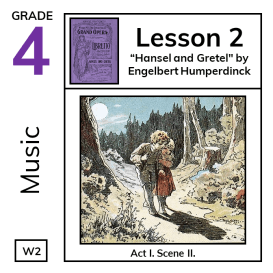
By: Engelbert Humperdinck
Week: 2
Just as Hansel and Gretel fall while dancing, their mother, Gertrude, enters and she is so angry at seeing them do no work that she boxes their ears. In her excitement, Gertrude gives the milk pitcher a push. It falls off the table, breaks in pieces, and spills all the milk. At this, Gertrude is beside herself, seizes a basket, and orders the children to go to the wood and pick strawberries. She tells the children they must not return home until the basket is full. Hansel and Gretel run off, while Gertrude, weary of life, sits sobbing herself to sleep [1].
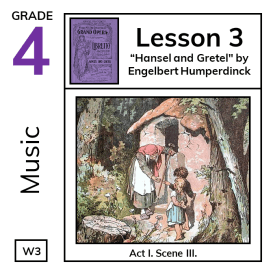
By: Engelbert Humperdinck
Week: 3
Hansel and Gretel's father, Peter the Broom-maker, is heard in the distance belting out a joyous song. He enters the home in a joyful mood. Peter wakes up his unhappy wife, Gertrude, to tell her that he has sold all his brooms at the fair for splendid prices. Peter shows Gertrude his basket full of provisions. Both are thus in fine humor until Peter asks where the children are. Gertrude says she sent them away in disgrace to the Ilsestein. 'The Ilsestein!' Peter says to his wife. 'Where the witches ride on broomsticks and devour little children?' Screaming "Oh horror!" Gertrude runs out of the house, Peter hurrying after her, to find Hansel and Gretel [1].
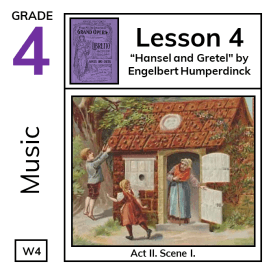
By: Engelbert Humperdinck
Week: 4
The second act shows a forest. Gretel weaves a garland of wild roses while Hansel searches for strawberries. It is sunset, and the Ilsestein looms high in the background. Hansel crowns Gretel queen of the wood, and she allows him to taste a strawberry. He gives her one in return and little by little the children devour all of the gathered strawberries. When the children realize what they have done, they become frightened. They want to pick more strawberries, but it is getting too dark. Hansel and Gretel want to leave but cannot find the way. Gretel fears being in the dark. She sees faces in trees and stumps and Hansel calls out to reassure her. When his echo answers, and Hansel grows frightened too. The children huddle together as a thick mist arises and hides the Ilsestein. Gretel, terror-stricken, falls on her knees and hides behind Hansel. At this moment a little man appears. The mist begins to rise, and the little man quiets the children [1].
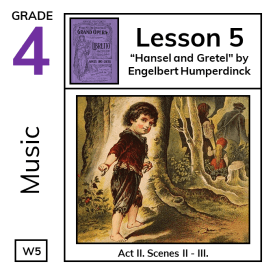
By: Engelbert Humperdinck
Week: 5
The little man is the Sandman, and he sings Hansel and Gretel to slumber. Half-awake the children recite their evening prayer and sink down on the moss in each other's arms. A dazzling light appears, the mist rolls itself into a staircase, and angels glide down the steps to encircle the two sleeping children. [1].
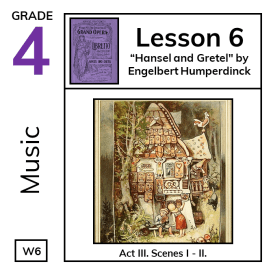
By: Engelbert Humperdinck
Week: 6
In the third act, the scene is the same, and the mist still hides the background. The Dawn Fairy shakes dewdrops on the children. They wake, but Hansel very lazily. They both have had dreams of angels coming to see them with shining wings. The mist now clears away and in the background the witches' house with a fence of gingerbread figures appears. An oven and a cage become visible near the house. Hansel wants to go inside the house, but Gretel draws him back. Hansel argues the angels beguiled their footsteps so why they shouldn't nibble a bit at the cottage? The children tiptoe to the fence and cautiously break off a bit of the cake [1].
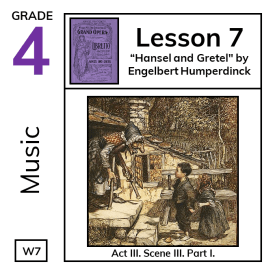
By: Engelbert Humperdinck
Week: 7
The witch's voice from within tells Hansel and Gretel to go on nibbling. The children like the gingerbread. It suits them famously and apparently suits the witch too as she watches them from her window. The witch comes out of the house as the children are joyously laughing, throws a rope about Hansel's neck, and caresses their skin. Hansel tries to get away and calls the witch names. The witch ignores him, saying how she loves them both and they are such dainty morsels. Hansel tries to run away and takes Gretel with him. But the witch casts a spell on them, and they freeze stock-still. The witch leads Hansel to the cage, shuts him in, and feeds him almonds and raisins to fatten him up [1].
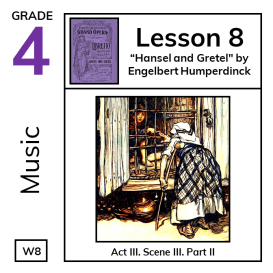
By: Engelbert Humperdinck
Week: 8
The witch disenchants Gretel with her magic stick and remarks how nice and plump she'll be when she's roasted brown. The witch opens the oven and puts more wood under it. The witch says the fire will soon be ripe to push Gretel in. In her joy, the witch rides wildly around on a broomstick while Gretel watches from the house. The witch calls Gretel out and opens the oven door. When the witch tells Gretel to peep in the oven, Hansel warns his sister to beware. Gretel pretends she does not understand how to look into the oven. Gretel secretly disenchants Hansel so that when the witch bends over and peeps into the oven, the children give her a big push and in she goes into the flames. The children celebrate their freedom, dancing wildly about. When the oven cracks open and falls into bits, groups of children suddenly surround Hansel and Gretel [1].
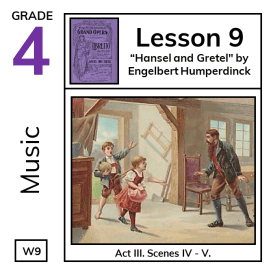
By: Engelbert Humperdinck
Week: 9
Hansel and Gretel disenchant the gingerbread children who are very grateful. As they are all dragging the gingerbread witch about, Hansel and Gretel's Father and Mother come in and are overjoyed at finding their children again [1].
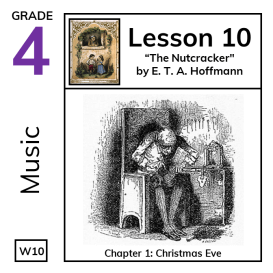
By: E.T.A. Hoffman
Week: 10
The Nutcracker Suite, Op. 71a is a ballet written by Pyotr Ilyich Tchaikovsky in 1892. It is performed by many ballet companies during the Christmas season. The story of the Nutcracker ballet is based on E.T.A. Hoffmann's story 'The Nutcracker and the Mouse King.' In the fantastically strange story, a girl named Maria Stahlbaum (often named Clara in the ballet version) receives a Nutcracker from her uncle on Christmas Eve. The Nutcracker transforms into a handsome prince. With the help of Maria, the prince defeats the Mouse King and his army of mice. Maria and the prince travel to the Land of Sweets and see magical dances and wondrous people and places. This lesson features chapter 1 of 'Nutcracker and the Mouse King' along with the ballet overture, or opening music of the Nutcracker ballet.
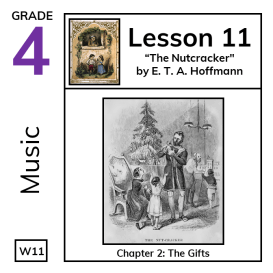
By: E.T.A. Hoffman
Week: 11
This lesson features chapter 2 of E.T.A. Hoffmann's story 'The Nutcracker and the Mouse King,' along with the March from the Nutcracker ballet, Nutcracker Suite, Op. 71a.
By: E.T.A. Hoffman
Week: 12
This lesson features chapter 3 of E.T.A. Hoffmann's story 'The Nutcracker and the Mouse King,' along with the Dance of the Sugar Plum Fairy from the Nutcracker ballet, Nutcracker Suite, Op. 71a.
By: E.T.A. Hoffman
Week: 13
This lesson features chapter 4 of E.T.A. Hoffmann's story 'The Nutcracker and the Mouse King,' along with Trepak (Russian Dance) from the Nutcracker ballet, Nutcracker Suite, Op. 71a.
By: E.T.A. Hoffman
Week: 14
This lesson features chapter 5 of E.T.A. Hoffmann's story 'The Nutcracker and the Mouse King,' along with the Coffee (Arabian Dance) from the Nutcracker ballet, Nutcracker Suite, Op. 71a.
By: E.T.A. Hoffman
Week: 15
This lesson features chapter 6 of E.T.A. Hoffmann's story 'The Nutcracker and the Mouse King,' along with Tea (Chinese Dance) from the Nutcracker ballet, Nutcracker Suite, Op. 71a.
By: E.T.A. Hoffman
Week: 16
This lesson features chapter 7 of E.T.A. Hoffmann's story 'The Nutcracker and the Mouse King,' along with the Dance of the Reed Flutes from the Nutcracker ballet, Nutcracker Suite, Op. 71a.
By: E.T.A. Hoffman
Week: 17
This lesson features chapter 8 of E.T.A. Hoffmann's story 'The Nutcracker and the Mouse King,' along with the Waltz of the Flowers from the Nutcracker ballet, Nutcracker Suite, Op. 71a.
By: E.T.A. Hoffman
Week: 18
This lesson features chapter 9 of E.T.A. Hoffmann's story 'The Nutcracker and the Mouse King,' along with the entirety of the Nutcracker Suite, Op. 71a.
By: E.T.A. Hoffman
Week: 19
This lesson features chapter 10 of E.T.A. Hoffmann's story 'The Nutcracker and the Mouse King,' along with the entirety of the Nutcracker Suite, Op. 71a.
By: E.T.A. Hoffman
Week: 20
This lesson features chapter 11 of E.T.A. Hoffmann's story 'The Nutcracker and the Mouse King,' along with the entirety of the Nutcracker Suite, Op. 71a.
By: E.T.A. Hoffman
Week: 21
This lesson features chapter 12 of E.T.A. Hoffmann's story 'The Nutcracker and the Mouse King,' along with the entirety of the Nutcracker Suite, Op. 71a.
By: E.T.A. Hoffman
Week: 22
This lesson features chapter 13 of E.T.A. Hoffmann's story 'The Nutcracker and the Mouse King,' along with the entirety of the Nutcracker Suite, Op. 71a.
By: E.T.A. Hoffman
Week: 23
This lesson features chapter 14 of E.T.A. Hoffmann's story 'The Nutcracker and the Mouse King,' along with the entirety of the Nutcracker Suite, Op. 71a.
By: Pyotr Ilyich Tchaikovsky
Week: 24
In Act 1 of Swan Lake, young prince Siegfried has reached a marriageable age, but has yet to fall in love. His mother wishes him to choose a fiancée and invites all suitable young ladies to a great feast for this purpose. On the evening preceding the feast, Siegfried spots a flock of swans, and dashes off with his friends to hunt them [1].
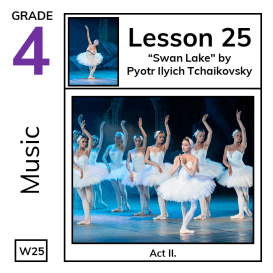
By: Pyotr Ilyich Tchaikovsky
Week: 25
In Act 2 of Swan Lake, young prince Siegfried learns the swans he has seen are the Princess Odetta and her attendant maidens, changed by magic and condemned by a demon to fly about in the day time as swans, and resume their human form only at night. Siegfried sees Odetta and falls in love with her. She tells him of her pitiful fate, from which she can only be saved by the love and faithfulness of a pure heart. Siegfried declares he will be her knight. Odetta warns him that from the moment that he is unfaithful to her she will fall for all time into the power of the evil one [1].
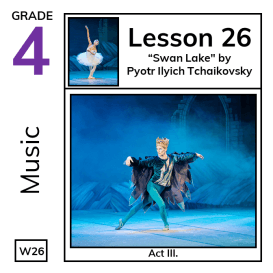
By: Pyotr Ilyich Tchaikovsky
Week: 26
In Act 3 of Swan Lake, in order to prevent the betrothal of Odetta, the demon appears at the feast accompanied by his daughter Odelia, to whom he has given the form of Odetta. Not realizing Odelia and Odetta are not the same person, Siegfried choses Odelia for his bride, and is therefore unfaithful to Odetta, who must now be sacrificed to the demon [1].
By: Pyotr Ilyich Tchaikovsky
Week: 27
In Act 4 of Swan Lake, Odetta, escapes her fate by throwing herself into the water at night time, when she has human form. When Siegfried discovers his error and hears the news of Odetta's death, he also puts an end to his life, but in the bittersweet ending, the souls of both are reunited in the magic world of everlasting happiness [1].
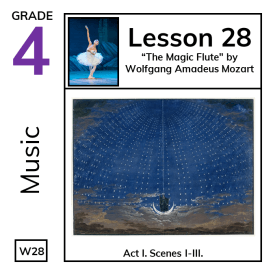
By: Wolfgang Amadeus Mozart
Week: 28
Mozart wrote "The Magic Flute," an opera in two acts, from March until July and in the September of 1791. On September 30, two months before his death, the first performance of "The Magic Flute" was given. The German composer Emanuel Schikaneder wrote the accompanying libretto. The first scene opens with Tamino, a handsome Egyptian prince, fleeing from a huge serpent. He trips while running and falls unconscious. Hearing his cries for help, three black-garbed Ladies-in-Waiting of the Queen of the Night appear and kill the snake with their spears. The ladies leave before Tamino recovers consciousness and sees dancing toward him an odd-looking man entirely covered with feathers. It is Papageno, a bird-catcher. Papageno tells the astonished Tamino that this is the realm of the Queen of the Night. Papageno, seeing that the snake is dead, does not hesitate to boastfully lie that he killed the monster. For this lie, Papageno is immediately punished. The three Ladies-in-Waiting reappear and place a padlock on Papageno's mouth [1].
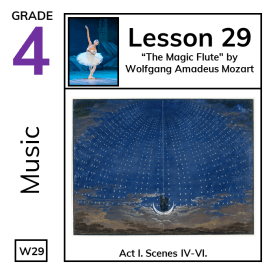
By: Wolfgang Amadeus Mozart
Week: 29
The three Ladies-in-Waiting show Tamino the miniature portrait of a lovely maiden, whose magical beauty at once fills his heart with ardent love. Enter the Queen of the Night. She tells Tamino the portrait is that of her daughter, Pamina, who has been taken from her by a wicked sorcerer, Sarastro. The Queen of the Night has chosen Tamino to rescue her daughter, and as a reward Tamino will receive Pamina's hand in marriage. The Queen and her ladies then disappear.
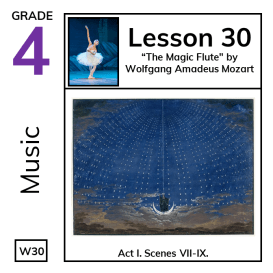
By: Wolfgang Amadeus Mozart
Week: 30
The three Ladies-in-Waiting return and remove the padlock from Papageno's mouth. The ladies give Papageno a set of bells and Tamino a golden flute. By the aid of these magical instruments, they will be able to escape the perils of their journey, on which they will be accompanied by three winged youths or genii. CHANGE OF SCENE. A richly furnished apartment in Sarastro's palace is shown. Monostatos, evil overseer of Sarastro's temple, is pursuing Pamina with unwelcome attentions.
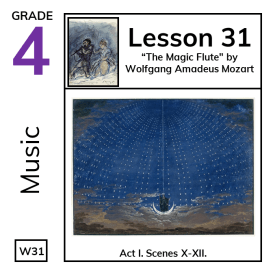
By: Wolfgang Amadeus Mozart
Week: 31
Monostatos flees upon the appearance of Papageno. The bird-catcher recognizes Pamina as the daughter of the Queen of the Night, and assures her that she will soon be rescued. In the meantime, the Three Youths guide Tamino to a grove where three temples stand. Tamino celebrates when he learns that Pamina still lives. Tamino plays his flute and hears Papageno answer. Tamino hastens forth and seeks to call his companion by playing on his flute.
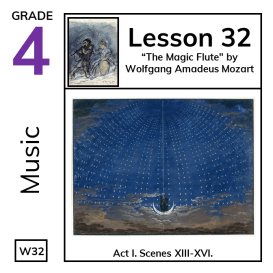
By: Wolfgang Amadeus Mozart
Week: 32
Papageno attempts to escape with Pamina, but is prevented by the appearance of Monostatos and some slaves, who endeavor to seize them. Papageno plays his magic chimes and sets Monostatos and his slaves dancing. A trumpet blasts announces the arrival of Sarastro. Pamina kneels at the feet of the High Priest and explains that she was trying to escape the unwelcome attentions of Monostatos. Monostatos now drags Tamino in, but instead of the reward from Sarastro he expects, receives a sound flogging. By the command of Sarastro, Tamino and Pamina are brought into the Temple of Ordeals, where they must prove that they are worthy of higher happiness.
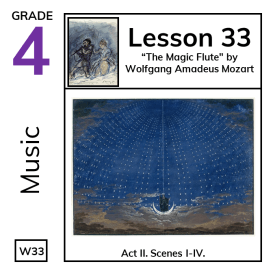
By: Wolfgang Amadeus Mozart
Week: 33
In the Palm Grove, Sarastro informs the priests of the plans which he has laid. The gods have decided that Pamina shall become the wife of the noble youth Tamino. Tamino, however, must prove, by his own power, that he is worthy of admission to the Temple. Therefore, Sarastro has taken under his protection Pamina, daughter of the Queen of the Night, to whom is due all darkness and superstition. In a twist, the Queen of the Night has become the young lover's foe and Sarastro the savior. But the couple must go through severe ordeals in order to be worthy of entering the Temple of Light, and thus of thwarting the sinister machinations of the Queen.
By: Wolfgang Amadeus Mozart
Week: 34
In succeeding scenes we see the fabulous ordeals which Tamino works to overcome with the assistance of his magic flute.
By: Wolfgang Amadeus Mozart
Week: 35
Tamino, with the assistance of his magic flute and his own purity of purpose, finally overcomes the ordeals with Pamina by his side.
By: Wolfgang Amadeus Mozart
Week: 36
Darkness is banished and Tamino and Pamina enter into the light of the Temple of the Sun. Papageno also fares well, for he finds and marries Papagena.